How to descale your kettle – 6 home remedies
In any water heater, from time to time, we find a treasure of minerals, namely the deposits of magnesium and calcium salts from hard water. And if we always try to prevent the occurrence of scale in the dishwasher and washing machine, then what can we say about the kettle, where it not only impairs its performance and leads to breakdowns, but also harms the health of households.
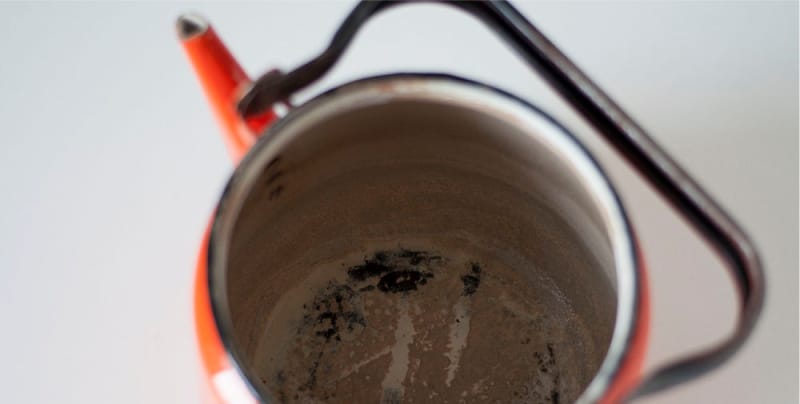
In this article, we have collected 6 of the most effective and affordable at home methods to help you descale your kettle. In fact, the secret of all folk remedies is very simple:
- Scale in a teapot or electric kettle is afraid of organic and inorganic acids, so almost all methods of removing it at home are based on the use of acid-containing products..
See also the material: How to clean an iron inside and out – 10 home methods.
Method 1. How to descale an electric kettle using vinegar
Manufacturers of electric kettles do not recommend using vinegar to remove mineral deposits – after all, it is too aggressive. But sometimes you can’t do without this powerful tool..
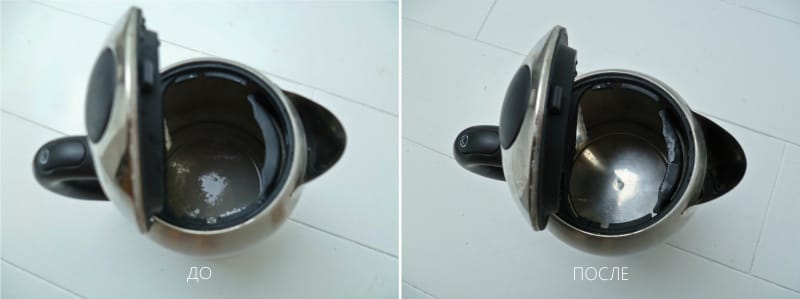
The method is suitable for: plastic, glass and metal teapots with a very large amount of old scale.
Ingredients: water – about 500 ml and vinegar 9% – a little less than 1 cup or vinegar essence 70% – 1-2 tablespoons.
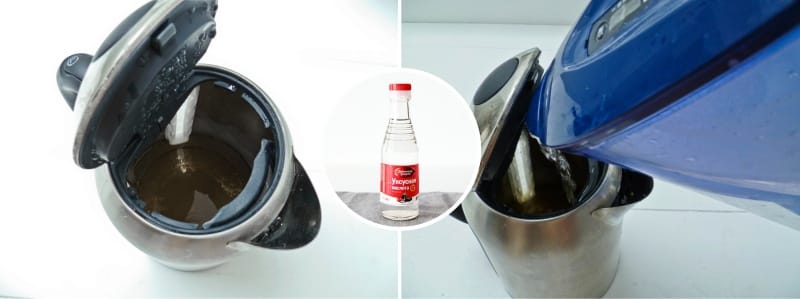
Recipe: pour water into a kettle and boil it, then pour acetic acid into boiling water and leave the scale to soak in the solution for 1 hour, during which you should periodically lift the lid and check how the scale is peeling off the walls of the kettle. If the scale did not go away on its own, but only loosened, then it will need to be removed with a sponge. Remember to boil water once or twice in a clean kettle, and then rinse thoroughly to rinse off any remaining vinegar..
Method 2. How to descale an electric kettle using citric acid
The method is suitable for: cleaning electric kettles made of plastic, stainless steel and glass with light or moderate dirt.
Ingredients: water – about 500 ml and citric acid – 1-2 tablespoons (depending on the degree of contamination). A quarter of a lemon can replace powdered acid.
Recipe: we also pour water into a kettle and boil, then pour citric acid into boiling water or put a quarter of a lemon and wait until the water cools down for about 1-2 hours (acid in hot water “fizzles”). If the scale is not old, then it will come off by itself. Otherwise, you have to make a little effort. Do not forget to boil water in a clean kettle and then rinse it thoroughly..
Method 3. How to get rid of limescale in a kettle of any kind using soda
Enamel and aluminum dishes are afraid of aggressive acids, so the first 2 methods of removing limescale are not suitable for them, but a regular soda solution can help you.
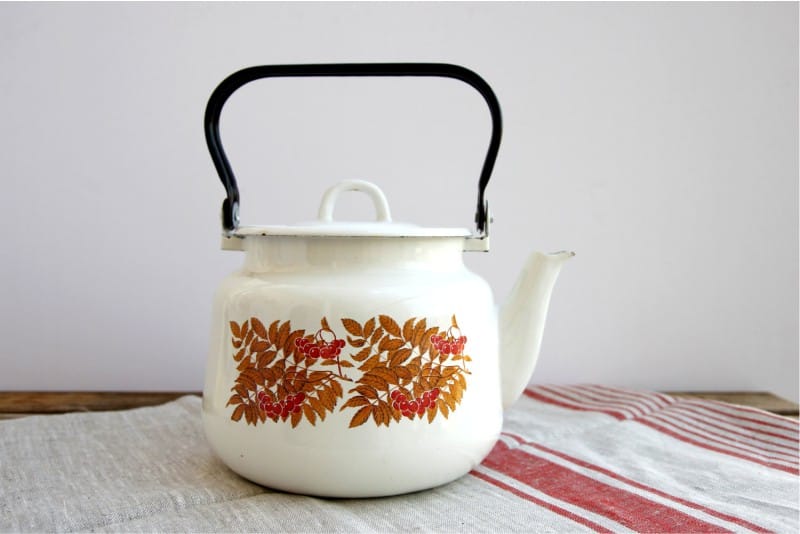
The method is suitable for: descaling both in ordinary enamel and aluminum kettles, and in any electric kettle.
Ingredients: baking soda, or better soda ash – 1 tablespoon, water – about 500 ml (the main thing is that it covers all the limescale).
Recipe 1: to remove scale from the walls of an enamel or aluminum kettle, you must first mix soda with water, then bring this solution to a boil, and then leave it to simmer over low heat for half an hour. At the end of the procedure, we wash off the remaining soda, for which we boil clean water 1 time, drain it and rinse the kettle.

Recipe 2: to wash an electric kettle with soda, you need to boil water, make a soda solution, and then let it cool for 1-2 hours. A more gentle way – pour soda into boiling water, and then leave the solution until it cools completely – during this time, mineral deposits will become softer, and it will be easier to wash them by hand.
Method 4. How to descale the kettle using Coca-Cola and Sprite
This method is not the most effective and economical, but why not try for fun?
The method is suitable for: descaling in ordinary stainless steel kettles and for electric kettles, but for enameled and tin kettles – with caution.
Ingredients: any carbonated drinks with citric acid in the composition – from “Coca-Cola” to “Fanta”, will do. But it is better to take colorless drinks, for example, “Sprite” or “Schweppes”.
Recipe: First we release gases from the drink, then pour 500 ml of liquid into a kettle and let it boil, and then cool. The result of the experiment can be seen in this video..
See also the material: How to clean a washing machine from dirt and scale in 5 steps.
Method 5. How to descale a kettle using apple or potato peels
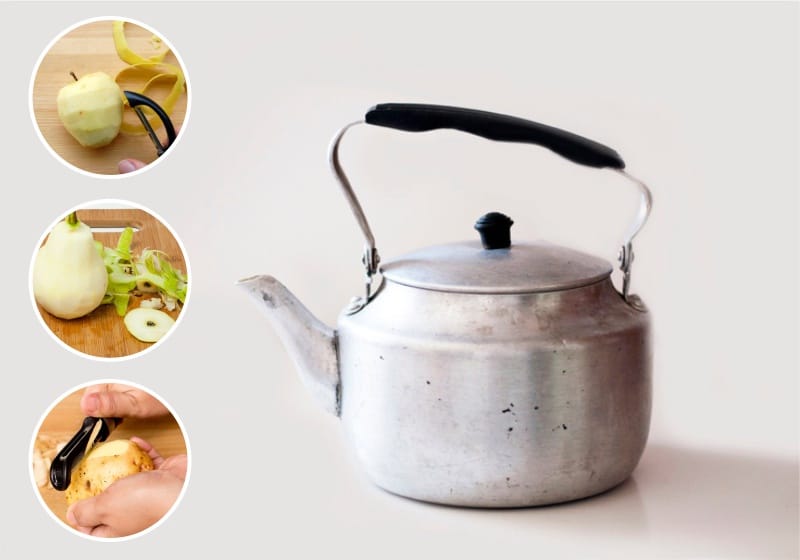
This product is suitable either for preventive maintenance or if limescale deposits are still weak..
Method suitable for: descaling common enamelled and metal teapots.
Ingredients: apple, pear or potato peel.
Recipe: put apple, pear or washed potato peels in a kettle, fill with water and bring to a boil. As soon as the water boils, leave the peel to cool for 1-2 hours, and then wash off the softened plaque with a sponge.
Method 6. How to descale a kettle using brine
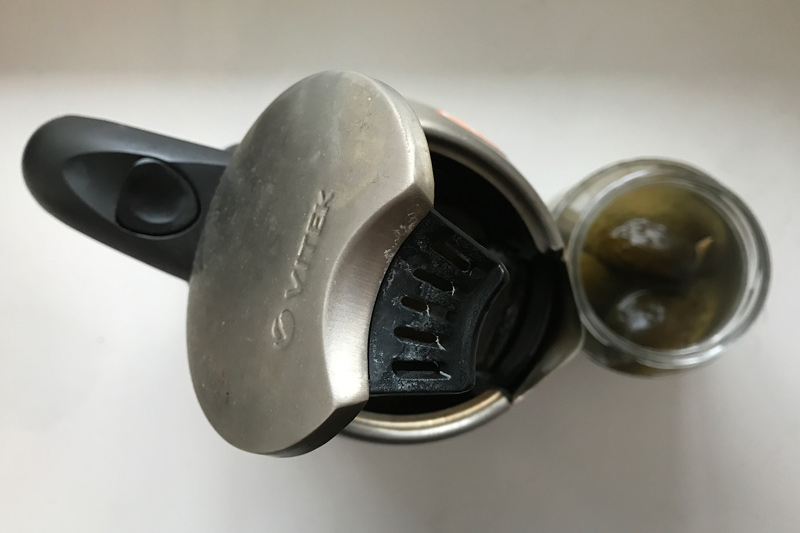
Since the brine contains organic acids, it can also be used to remove scale and rust. Therefore, if you have a pickle from under cucumbers or tomatoes at your fingertips, which, as often happens, has nowhere to put it, feel free to use it..
Method suitable for: descaling common enamelled and metal teapots.
Recipe: pour the brine into a kettle through a sieve (so that nothing superfluous remains in it), bring it to a boil, then leave the brine to cool for a couple of hours. Using a sponge, we clean off the remains of limescale and rust and, finally, rinse the kettle clean with running water..
We clean the microwave in 5 minutes – 6 express ways.
Some Helpful Prevention Tips
In order not to run your kettle and always drink pure drinks, follow these 3 simple rules:
- Try to descale your kettle regularly – once a month or every two months. For preventive cleaning, delicate products such as fruit peels or brine are suitable..
- Try to boil only filtered water. It is good for both your health and the teapot.
- Try to pour out any remaining water that remains on the bottom of the kettle and rinse it before adding fresh water for boiling..
How to clean the outside of the kettle from carbon deposits and grease
Often, aluminum and enamel teapots are covered with carbon and grease on the outside. If first aid in the form of dishwashing liquid and a sponge did not work, try the following 3 methods (for regular enamel and aluminum teapots, as well as stainless steel teapots).
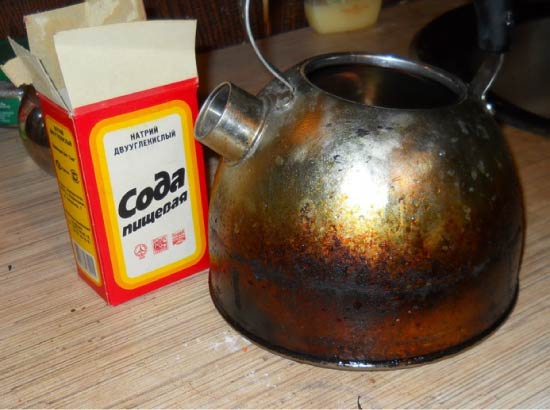
Method 1.
Step 1. Heat the kettle so that it is warm enough but not scalding.
Step 2. Prepare a 3: 1 mixture of baking soda and water.
Step 3. Using a sponge, treat all contaminated surfaces with the resulting solution, leave for 5 minutes (optional), and then clean the carbon and fat, making circular movements with the hard side of the sponge.
Step 4. Finally, wipe the kettle clean.
Method 2.
You can clean the outside of the kettle from old soot and fat by boiling in a soda solution.
Step 1. Fill a large pot / basin / metal bucket with water.
Step 2. Dissolve soda in water at the rate of 1 tablespoon per 1 liter of water.
Step 3. Dip your stainless steel dish into the water and turn on the fire.
Step 4. When the water boils, boil the kettle for another 30 minutes, and then remove the container from the heat and leave to cool.
Step 5. Use the hard side of the sponge to clean the residues of carbon and grease and finally rinse under running water.
Method 3. Only for teapots made of stainless steel or aluminum
Aluminum kettles and stainless steel kettles can be cleaned from the outside of carbon deposits, rust and grease by boiling them in a vinegar solution. Just follow the previous instructions, but use 3 tbsp 9% table vinegar instead of baking soda. spoons for 1 liter of water.
Question answer
Why you can’t clean an electric kettle with vinegar?
There is a widespread belief that it is impossible to clean the kettle with vinegar, as it damages the O-ring that bends around the heating element, and as a result, it can provoke a leak. This can really be the case if the scale has already started to hit the ends of the heating element, broken the tightness and opened access to the ring. In this case, vinegar will only aggravate the situation and very soon a leak may indeed appear. However, if the kettle is relatively new and is regularly descaled with a weak vinegar solution or other means, then problems should not arise, because the seal simply does not come into contact with the contents of the kettle. Moreover, the manufacturers themselves recommend cleaning electric kettles with vinegar or special descaling agents. You can check this in the instruction manual for your device. If your kettle has been used for a long time and the scale is fairly neglected, then we recommend cleaning it with citric acid or a very weak vinegar solution. By the way, citric acid is also good because it rinses off more easily and does not smell so harsh.
How to clean a kettle with decalcifier?
The manufacturer’s instructions must be followed. As a rule, in order to clean the kettle with anti-limescale, the contents of the sachet must be poured into a kettle filled with water, then the resulting solution must be boiled and, finally, the kettle must be thoroughly rinsed with clean water and run empty 1-2 times..


